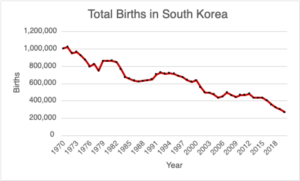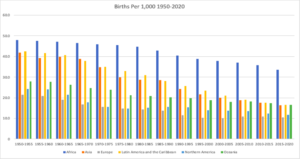If you are younger than fifty, you will probably witness in three or four decades something that no human being has seen in the last 60,000 years: a prolonged decline in the human population. The decline will not be caused by an epidemic or climate change, but rather by the collapse of fertility around the world.
To glimpse humanity’s demographic future, one can look to South Korea. In 1960, 1,080,535 South Koreans were born. At the time, South Korea had a population of 25,012,374. In 2020, however, South Korea recorded only 272,410 births in a country of 51,829,023 people.
In other words, South Korea’s birthrate fell from 43.2 per 1,000 in 1960 to 5.3 per 1,000 in 2020. In sixty years, the birthrate in the Republic of Korea collapsed by 88 percent.
Start your day with Public Discourse
Sign up and get our daily essays sent straight to your inbox.South Korea’s numbers cannot be dismissed as a product of COVID-19. The pandemic only became a major problem for Korea at the end of February 2020. Because human gestation lasts about 40 weeks, all births before the beginning of December 2020 could not have been influenced by the outbreak of COVID-19. The true effects of COVID-19 on the birth rate, whatever they may be, will not become visible until 2021 concludes.
The Republic of Korea also had very restrictive abortion laws before 2021, and there is no indication that women had more illegal abortions in 2020 than in previous years. 2020’s birth numbers are consistent with South Korea’s long-term decline in the birthrate.
What’s in Store for South Korea?
To understand the future of South Korea’s demography, I like to apply the “Rule of 85.” This rule is based on the fact that life expectancy in most advanced countries is approximately 85 years. If 1,000 people are born each year in country A, and this number is constant, the country’s population in the long-term will be 85 times 1,000 (85 years of average life per 1,000 new people per year). Now, let’s apply the “Rule of 85” to South Korea: 85 times 272,410 (the number of births in 2020) = 23,154,850.
The “Rule of 85” is a rough but useful approximation. It overestimates the population when the fertility rate (the average number of children per woman) is less than 2.1, the approximate fertility-replacement rate (this number accounts for infant mortality). Because more boys are born than girls (the natural ratio, without sex-selective abortions, is about 105 boys per 100 girls), out of the 1,000 births only 485 will be girls. When these girls grow up, if they have fewer than 2.1 children on average, they will be mothers of fewer than 1,000 people. Therefore, in the long term, the population will be less than 85,000 people. On the other hand, the “Rule of 85” underestimates the population in the long term when the fertility rate is greater than 2.1.
In the case of South Korea, 2020’s fertility rate was 0.84, far below the replacement rate. Therefore, in a few decades, the population of South Korea (ignoring immigration, natural disasters, etc.) will be far fewer than our prediction of 23 million. At the current birthrate, the number will be closer to 12 million.
I like using South Korea as an example for many reasons. The first is because, when I use the United States, China, or other countries as an example of declining fertility, readers tend to react with ideological prejudgments (“it’s the president’s fault!”). Or readers get bogged down by issues that, when closely examined, are not as important for fertility as they might seem (youth unemployment in Europe, the legacy of China’s one-child policy, etc.). Most westerners have a superficial understanding of South Korean politics and culture (Do you know the name of South Korea’s president? Is the ruling party left- or right-wing?), making it a perfect country to explain what is happening demographically.
The second reason is that South Korea, although somewhat extreme, is representative of what is happening in many other countries. When we discuss birthrates, the country that tends to spring to mind is, of course, China. In 1990, ten years after the introduction of the one-child policy, China recorded 23,910,000 births (meaning a crude birthrate of 21.06 per 1,000). In 2020, with all birth restrictions removed, 12,050,000 people were born (a crude birthrate of 8.54 per 1,000).
The Chinese authorities tell us that some 10,010,000 people died in 2020 (likely an underestimation, but let’s work with it). The data give us a natural population growth of 2 million, a number that might seem massive if it weren’t for the fact that China’s total population is 1.4 billion people. Again, using my “Rule of 85” we determine that, with the number of births, in a few decades, China’s population would decrease by 27 percent, falling to 1.02 billion. In fact, since China’s birthrate is 1.3 per woman, China’s population could drop to around 700 million.
The Two Asian Giants
The other great Asian giant, India, has a higher birthrate than China does, with some 27 million births in 2019 and a fertility rate right around the replacement rate. The “Rule of 85” estimates, in this case, that the population of India in the long term will be around 2.2 billion people. With current figures, the long-term population of India (2.2 billion) is predicted to be more than three times greater than China’s (700 million). That would entail a monumental geostrategic change.
In this case, the “Rule of 85” estimate is likely inflated, as India has a lower life expectancy. Personally, I predict that India will also experience a major drop in births in the next ten years. Already, Indian states with social policies that prioritize education and women’s rights, such as Kerala, have had fertility rates significantly below 2.1 for many years. Experience shows that undeveloped regions tend to adopt their more developed counterparts’ birthrates. Take Turkey as an example: during the 1980s and 1990s, fertility declined only in Istanbul and the westernmost provinces. But in 2020, Turkey’s eastern provinces followed suit—resulting in a nationwide birth rate of 1.76.
My prediction, based on recent research, is that the global fertility rate will hit the key threshold of 2.1 around 2030. This means that the world population would reach its peak between 2050 and 2060, then start decreasing from that moment on.
The story is the same in the Americas. Latin America and the Caribbean as a whole already have fertility rates below 2.1. Under their current trends, the populations of Argentina, Chile, and Brazil may begin to shrink in about ten years. Mexico and Colombia will suffer the same fate in about twenty years. In North America (the United States, Canada, and Bermuda) the situation is even more dire, with a weighted average fertility rate of 1.68, well below replacement.
There appears to be a great exception to this worldwide trend of decreasing fertility: Africa. Yet even there, as the standard of living and wages rise, the birthrate decreases. Morocco and Tunisia already have a fertility rate around 2.1. Demographic changes are beginning to emerge in sub-Saharan countries, too. Cape Verde, for example, is a small country, but it has already crossed the 2.1 threshold. Many others will follow in a few years.
However, even if Africa maintains a high birth rate for several decades, it will not be enough to change the global aggregate effect of reduced births. The world fertility rate in 2019 was, according to the World Bank, 2.403. My prediction, based on recent research, is that the global fertility rate will hit the key threshold of 2.1 around 2030. This means that the world population would reach its peak between 2050 and 2060, then start decreasing from that moment on.
Is Population Decline Inevitable?
My predictions are not set in stone. There are many things that even the most sophisticated mathematical operations cannot predict or measure. The composition of the world’s population may change dramatically in the coming decades.
Fifty years ago, there were no major differences in birthrates between Americans who reported attending a religious service at least once a week (the “religious”) and those who did not (the “secular”). Today, those differences are much more pronounced. While the fertility of both groups has fallen, the “secular” birthrate fell from around 2.8 to 1.5, whereas the “religious” fell from 3 to 2.2. Even more surprisingly, the “religious,” on average, earn less income than their secular counterparts.
Real-world evidence of the religious–secular gap in births is plentiful. Go to any traditional Catholic parish and you’ll see legions of young children bursting out of Ford Transit Minivans. A park in a Hasidic neighborhood teems with playing children, but a park in Greenwich Village will only feature thirty-year-olds doing yoga.
In Israel, the high fertility rate of the Arab and Ultra-Orthodox Jewish population has generated changes in the country’s political and budgetary makeup. In India, part of the reason fertility has fallen more slowly is because of the Muslim population’s higher birthrates. Consequently, India’s Muslim population grew from 10 percent in 1947 to 15 percent today.
The second reason my prediction might not come true is that governments are already reacting to this drop in fertility. Many European countries have already begun implementing programs meant to raise fertility rates. In some cases, such as the Czech Republic, there is some evidence that an increase in birth rate was the result of government policies. In 2020, the Czech fertility rate was 1.71, compared to 1.132 in 1999.
The Chinese government, in its typical heavy-handed fashion, has also implemented several policies intended to raise birthrates. So far, the Chinese Communist Party has implemented policies meant to reduce the cost of education, encouraged couples to have more children, “invited” film and television industries to promote traditional family values, and dramatically restricted abortion on demand.
The third unknown factor about my prediction is mortality. As mentioned before, the population of a country depends on its number of births and life expectancy. In the coming years, will life expectancy increase? Will it decrease? Nobody knows. There are signs that life expectancy plateaued in Europe’s richest countries around 2014, well before the outbreak of COVID-19. This plateau could possibly be attributed to a lack of life-extending medical innovations: for example, new cancer treatments help patients’ quality of life, but they offer very little in terms of life expectancy.
Perhaps life-expectancy-boosting innovations have been canceled out because of an increase in life-expectancy-reducing habits (e.g., drug abuse, living alone, depression, etc.). Will, as one of Moderna’s founders claimed in a recent meeting, mRNA technology bring about a medical revolution in dozens of diseases? I can’t say. Public health is not my area of expertise.
Finally, country by country, an additional demographic factor is at play: emigration. Even though deaths outnumbered births, in 2020 the population of South Korea continued to grow because of immigration. With regard to immigration, one must remember that the planet has net zero immigration (for now at least!)—migrants must leave one country to arrive at another. After all, my prediction is about global population decline.
I can’t think of a country that could draw a migratory flood sufficient to halt its falling population. Before I calculated that, at the current rate, South Korea’s population will fall from 53 million to 12 million in a few decades. If South Korea wants to maintain its population, it will have to bring in 39 million foreigners (largely from non-Asian countries—their immediate neighbors’ populations aren’t faring well either). If South Korea manages to attract mass migration, native Koreans would compose only 25 percent of its population. Ask yourself: do you think that Korean voters will agree to become a minority in their own country? Note that I do not judge these decisions as either positive or negative: Koreans must decide their destiny, not I. But it’s difficult to imagine that such a profound demographic change would be widely accepted.
In closing, I hope that I have convinced you that the world’s demographic future is, to put it lightly, unusual. Not only is fertility declining, it is collapsing faster than I would have predicted ten years ago. I never imagined that Thailand would have a negative natural growth rate in 2021, or that Saudi Arabia’s fertility rate would fall below the replacement level. Although a full analysis of this phenomenon is beyond the scope of this article, one thing is clear: the political, social, and economic consequences of such a demographic collapse will be tremendous.
This article was originally published in September 2021 at El Confidencial, a leading Spanish digital newspaper. We are grateful to Professor Jesús Fernández-Villaverde for his permission to publish it in English here, and to Robert Kaminski for his translation.
















